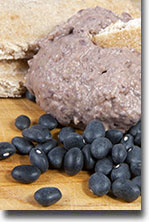 Recipes often recommend soaking beans in water overnight before cooking. A quick-soak alternative is to bring the beans and water to a boil and let them stand for an hour or so before cooking.
Recipes often recommend soaking beans in water overnight before cooking. A quick-soak alternative is to bring the beans and water to a boil and let them stand for an hour or so before cooking.
The cooking time of beans varies from bean to bean. I prefer the “quick soak” variant, and it is easy to see why: For most beans, it significantly reduces the cooking time (and thus the time you need to watch the pot and presumably the energy), and it doesn’t require you think of soaking beans the night before. If you are happy and get good results without soaking, I don’t think there’s a compelling reason to switch.
However, soaking beans overnight has some advantages. Soaking decreases cooking time. That’s the main reason to do it. With some beans, the difference in time is minimal, but with tougher beans that take longer to cook (e.g., black beans), soaking can reduce cooking time significantly, particularly if the beans are a little older and more dried out.
The reason is because the first period of time in water is spent hydrating the seed coat. Once the seed coat is completely hydrated, water can flow through the surface and begin to cook the interior of the bean. The hydration of the seed coat can happen in cold water as well as hot water, so soaking beans will allow that process to begin before cooking. With most beans, the difference in cooking time might be 15-30 minutes (perhaps not enough to be significant for a dish that’s cooking for a couple of hours anyway), but with some it might be as much as an hour.
Some say that soaking helps to maintain shape or keep beans intact, but I’ve found that really depends on the type of bean, how old they are, and how they are cooked. In many cases, the best-looking beans I’ve made have come from batches that were never soaked but cooked slowly (start in cold water and slowly bring up to a simmer).
The other main reason often cited is to prevent flatulence. However, if you throw out the soaking water, you also throw out lots of nutrients. However, research recommends throwing this water out to get rid of toxins.
Recent research suggests that long slow cooking is a better solution and probably gets rid of more of the flatulence-causing components than a soak followed by a quick cook. You get to retain more nutrients. One kind of troublesome carbohydrate is the oligosaccharides (which are water soluble). But the latest research suggests that the oligosaccharides are not the primary source of gas. The cell-wall cements generate just as much carbon dioxide and hydrogen as the oligosaccharides–and beans generally contain about twice as much of these carbohydrates as they do oligosaccharides.